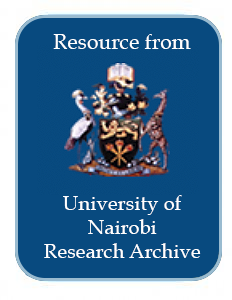Resource information
Cenchrus ciliaris L. (African foxtail grass) and Eragrostis superba Peyr. (Maasai lovegrass) grass
species that are native to the rangelands have been promoted for rehabilitation of degraded areas
and improve forage production. A major challenge to successful reseeding of the rangelands has
been lack of certified seeds of these species in the formal seed systems except through collections
from the wild. The main objective of the study was to contribute to improved livestock production
in the ASALs through characterization, evaluation and identification of higher yielding ecotypes
of C. ciliaris and E. superba that can be submitted for certification process.
Germplasm was collected from the wild in four agro-ecological zones (AEZ), represented by
Kilifi, Taita Taveta, Makueni and Kajiado Counties for AEZ III, IV, V and VI, respectively. Seeds
of eleven ecotypes for C. ciliaris and nine for E. superba were processed and planted in five rows
of four metres long in randomized complete block design with three replicates at KALRO Kiboko
Research Centre. Data were collected for stem, leaf and flowering traits while plant samples were
analysed for crude protein, crude fibre, ash, percent dry matter, and in-vitro digestibility of dry
matter. The levels of correlation and relatedness among the ecotypes was determined. Two clusters
of robust and small sized types were formed using plant height, stem thickness, leaf length and
leaf width. The small sized ecotypes were clustered as early flowering while the robust types were
late flowering indicating presence of early and late maturing ecotypes among the C. ciliaris
collection. MGD1 ecotype was found to be different from the rest due to clustering as a robust and
early flowering type. The recorded correlation between stem and leaf traits and nutritive
components, CP and INVDMD, in C. ciliaris ecotypes could be used to select for higher yielding
plants for the target nutritive values within the ecotypes. Clustering patterns for E. superba
ecotypes remained the same using either 16 different morphological traits, selected robustness
traits, namely, plant height, stem thickness, leaf length and leaf width, or seed yield traits. KBK1
and KBK2 ecotypes of E. superba remained clustered together in one group as robust types against
the rest of the seven ecotypes. Effect of the environment of collection including climate and
grazingland management may have influenced the plant size and maturity time among the C.
ciliaris ecotypes. The identified different clusters of C. ciliaris ecotypes allows for selection along
maturity time such as within the early flowering types, late flowering types and MGD1 as an early
maturing and robust type.
Significant genetic differences (<0.01) was recorded among ecotypes of C. ciliaris where Kajiado
population recorded the highest diversity indices while Kilifi and Narok collections were the most
distant populations. High genetic differentiation between populations of E. superba was recorded
with Fst=0.237, Gst= 0.534, mean Shannon diversity index (I=0.357) and Nei’s genetic diversity
index (h=0.223) among populations. There was possible exchange of genetic materials between
ecotypes of E. superba conserved in common gardens.
Evaluation of biomass yield among C. ciliaris ecotypes was done in three sites Kiboko, Buchuma
and Mtwapa KALRO Centres. Plots were established in three replicates of five rows each
measuring four metres long. Dry matter yield data was collected for two seasons and analysed
using AMMI stability value (ASV) and Yield stability index (YSI). Mean dry matter yield (DM)
of the C. ciliaris ecotypes across three sites ranged from 3986 to 11,792 kgha-1 where the small
sized types had the lowest yield. KBK3 ecotype was ranked the most stable across sites with ASV
and the highest yielder with YSI. Ecotype KBK1 was the most suitable for Kiboko and Mtwapa
sites and MGD3 for Buchuma.
Evaluation of farmer knowledge and perceptions on ecotypes of C. ciliaris grass species was
carried out using Focused group Discussions (FGDs) where farmers developed criteria for
preferred grass types. The farmers knew of the existence of various ecotypes of C. ciliaris and had
varied perceived preferences on them. TVT1 and KLF1 ecotypes were selected by over 80 % of
the participants due to their perceived tolerance to droughts and heavy grazing. The criteria for
selection of ecotypes by farmers varied depending on the type of utilization of the grass. Successful
development and promotion of grass varieties should consider the mode of utilization by the target
farmer group


